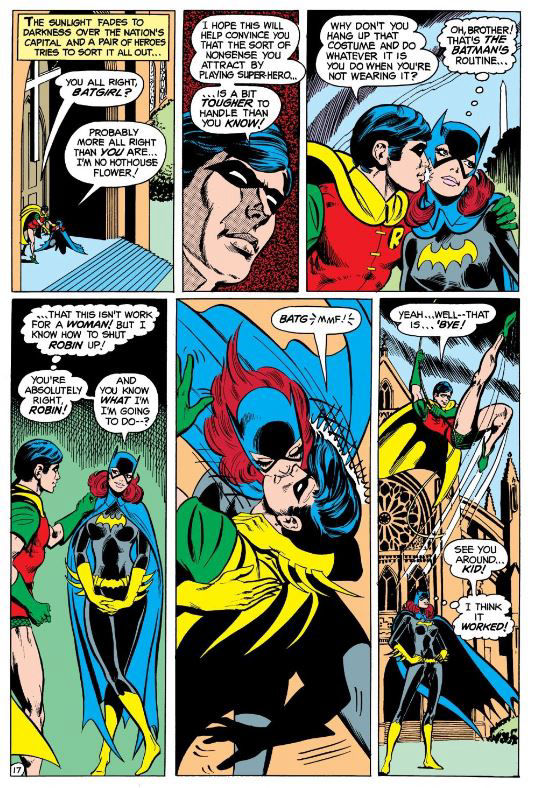
Batman Family was introduced in 1975 was a mixture of reprinted stories and original content. The lead story by writer Elliot S! Maggin and artist Mike Grell teamed up Batgirl and Robin – a partnership that was dubbed “the Dynamite Duo”, as opposed to the “Dynamic Duo” between Batman and Robin.
Barbara Gordon had moved on from being a Gotham City librarian, and was now a newly elected congresswoman, living in Washington, D.C. Barbara or “Babs” was the Alexandria Ocassio-Cortez of her day. And Dick Grayson was interning as her aide, but Babs was unaware the Teen Wonder was working for her.
The Dynamite Duo faced off against the ghost of Benedict Arnold. Robin gave Batgirl a peck on the cheek and a condescending speech. Batgirl decided to shut Robin down with a passionate kiss.

After an all-reprint second issue, the pair meet again in the third issue. Dick is worried about her seeing Dick Grayson and Robin in the same place. And yes, by the issue's end, she had deduced his secret identity.
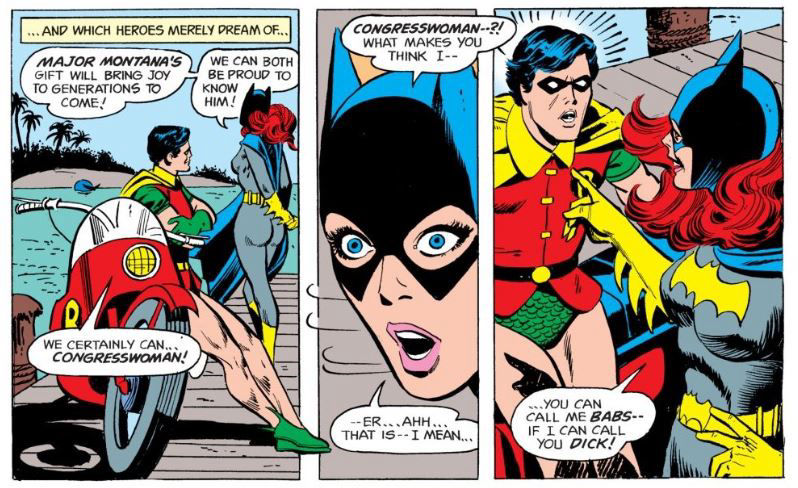
The fourth issue features Robin in a solo Christmas tale by Bob Rozakis, set around Hudson University with the familiar characters of Lori Elton and Chief McDonald. The Dynamite Duo reunite under writers Elliot S! Maggin and Cary Bates for issue 5 to take on MAZE – an organization which specializes in contract killing. MAZE would bedevil Robin for the rest of the 1970s. Issue 6 features solo Robin and Batgirl adventures. But in issue 7, Bruce Wayne takes note of the budding relationship. Dick denies having any interest in Batgirl. “She’s got to be seven years older.” Bruce responds “Older women looked pretty good when I was your age, kid.”
This adventure – the final one written by Maggin – has Robin and Batgirl fight the husband-and-wife criminal duo the Sportsmaster and the Huntress. Batgirl and Robin are forced to compete against each other. And while the Teen Wonder might be named for Robin Hood, we learn Batgirl is the superior archer.
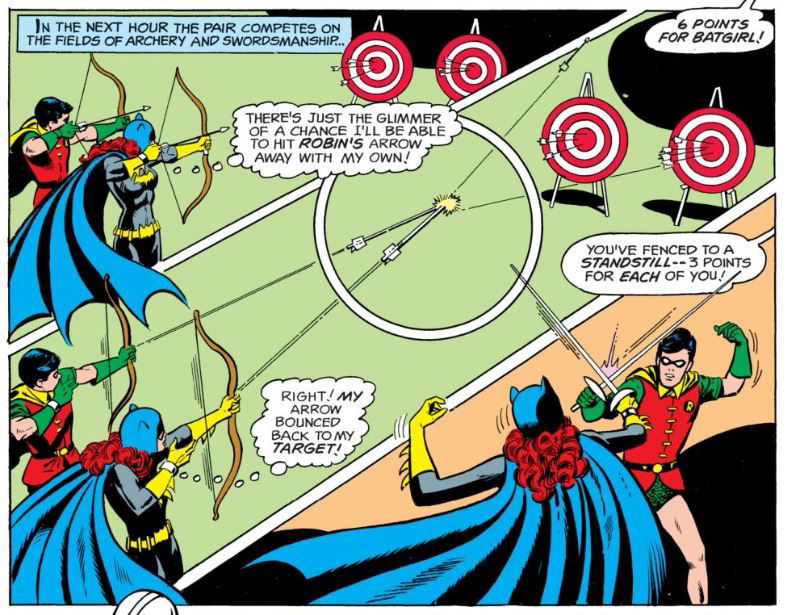
Bob Rozakis would continue to write tales of the Robin / Batgirl partnership. Issue 11 teases a mock wedding ceremony for the two heroes, hosted by criminals. And in issue 13, Robin confesses his complicated feelings of love to Batgirl, although he discovers she’s fallen asleep.
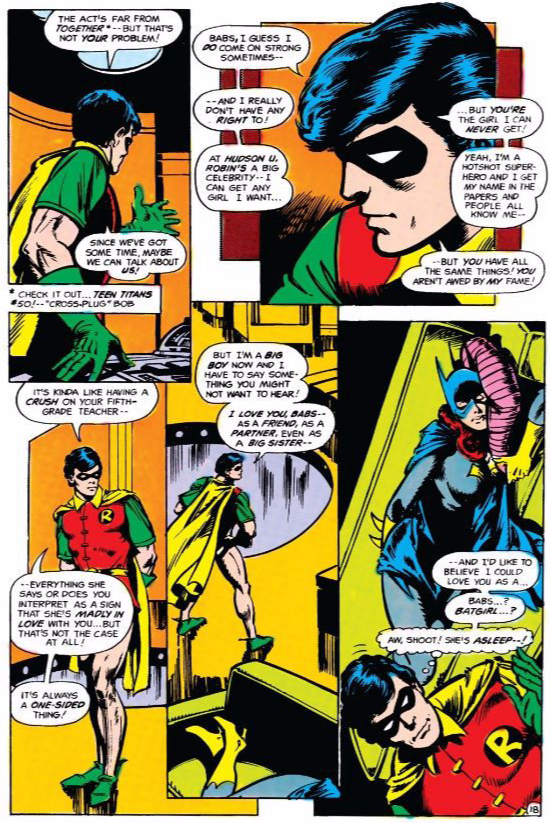
Dick Grayson's complicated feelings for Barbara Gordon would remain a part of the comics for the next 40 years. Although the feelings would be a little less complicated in later years when changes to the continuity of DC Comics removed Barbara Gordon's time in Congress and de-aged her to being approximately the same age as Dick Grayson. It would no longer seem "like having a crush on your fifth-grade teacher" but other circumstances would conspire to keep their romance as a relationship that "should be" rather than one which truly "is".
Meanwhile, back in the 1970s, Dick Grayson already had a girlfriend. Rozakis spent more time at Hudson University than Maggin did. Dick’s girlfriend Lori Elton was not happy at the amount of time Dick Grayson spent thinking about Barbara Gordon, and how little time he spent on his romance with her, or on his studies.
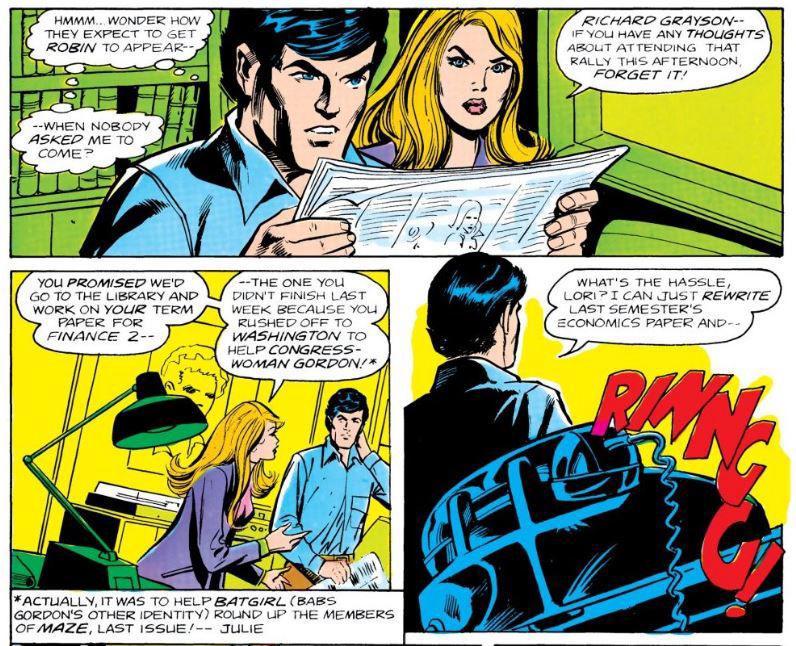
In issue 14, she had her uncle Frank (Chief McDonald) put out an APB (all-points bulletin) on her missing boyfriend. And by Batman Family #18, Lori had broken up with Dick and started dating Hudson University student Dave Corby.
But Bob Rozakis had introduced yet another woman into Dick Grayson’s life, the daughter of an old enemy … well, sort of.
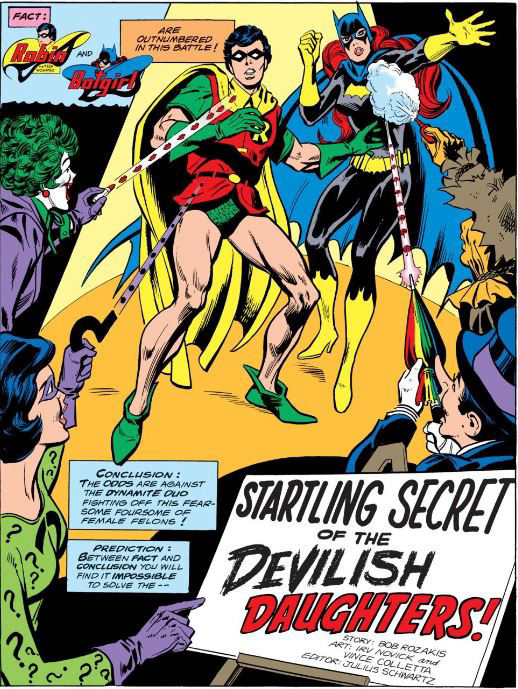
Duela Dent in her various identities from Batman Family #9
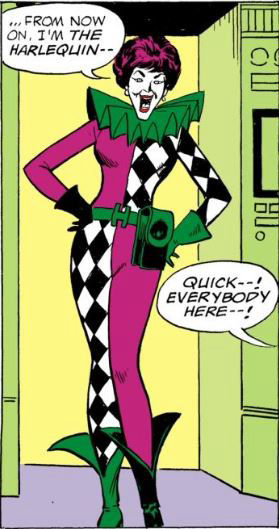
Duela Dent as the Harlequin in Teen Titans #48
In Batman Family #6, writer Bob Rozakis and artist Irv Novick introduced a new mischievous villain. She called herself the Joker’s Daughter and wore an outfit similar to that of Batman’s greatest foe.
But when the same character appears in Batman Family #8, she’s now disguised as “Catgirl” – another take-off on a Batman villain. Rozakis had planned to stretch this gag out for months, but editor Julius Schwartz told him to knock it off and wrap it up. So, when the same character returns to bedevil Robin and Batgirl in issue 9, she disguises herself as the Scarecrow’s Daughter, the Riddler’s Daughter and the Penguin’s Daughter. Along the way, she also discovered Robin’s true identity as Dick Grayson. Meanwhile, Robin reveals he knows her identity too – Duela Dent, daughter of the Batman foe Two-Face.
Duela explains that all her minor crimes were just to get Robin’s attention, and that she’d secretly sent money to pay for any damages caused by her activities. She wants Robin to nominate her for membership in the Teen Titans.
The original run of the Teen Titans ended with Teen Titans #43, cover dated February 1973. But the series resumed with issue 44, with a cover date of November 1976. Bob Rozakis was the new writer of this team of sidekicks, and he brought over the Joker’s Daughter, although after a confrontation with her true father Two-Face she changes her name to Harlequin.
Writers in later decades would depict her Two-Face parentage as yet another lie, and portray Duela as a serial liar, a crazy fan-girl or a visitor from another dimension. Yet in the 1970s, she was a part of Robin’s life.
The Teen Titans broke up in issue 53 (cover dated February 1978). A lot of comics would be cancelled in the months to come. A 1978 DC Comics ad campaign announced a “DC Explosion” of new titles and increased page counts – but poor sales and rising prices actually resulted in layoffs and cancelled comics. Fans dubbed this the “DC Implosion”. Batman Family was a victim of the DC Implosion as the series ended with issue 20 (cover date November 1978). But the Batman Family concept lived on in a new home.
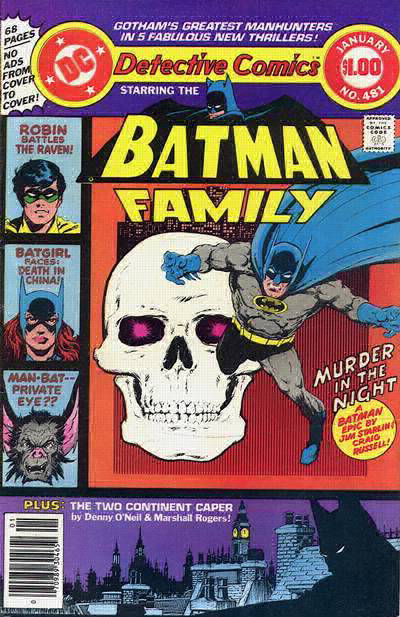
Detetcive Comics #481 with the Batman Family logo added
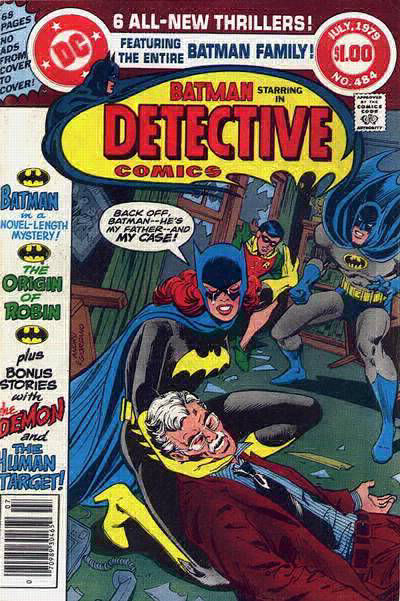
Detective Comics #484, the Batman Family logo is gone by the concept continues
As DC Comics was cutting back on its many comics, the powers-that-be decided one of the Batman comics had to go? The worst selling one was the one that didn’t have Batman in the title – Detective Comics. But this was a comic of historic significance – continuously published since 1937. Batman first appeared in 27th issue and Robin debuted in the 38th issue. Even the company’s name – DC Comics – was made from the initials of Detective Comics, their one-time success.
So, DC cancelled Batman Family, but then transformed Detective Comics into Batman Family with issue 481 (cover dated January 1979). For the first three issues of the new format, the cover proclaimed “Detective Comics starring the Batman Family” – with the old Batman Family logo dominating the cover. With issue 484, the prominent Detective Comics logo returned, but it continued the Batman Family format until issue 495 (cover dated October 1980).
The old Batman Family comic had run a contest for readers to design a new costume for Robin. They weren’t really changing his costume, but iissue 481 of Detective Comics Robin did temporarily try out three reader-designed costumes.
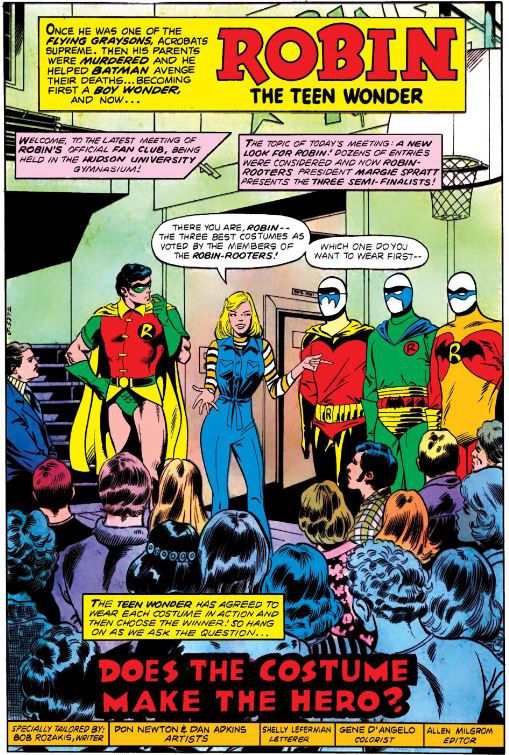
One of Robin’s new costumes had a jet-pack which allowed him to have an aerial duel with Raven, a black-clad foe from Batman Family #19. The following issue revealed that the Raven was an agent of MAZE. That issue introduced another MAZE agent – the Card Queen. The story wrapped up in Detective Comics #483, when Robin reveals that both the Raven and the Card Queen are familiar figures. Card Queen is really Duela Dent, who was recruited because they knew of her family connection to Two-Face, but not of her membership in the Teen Titans. She joined MAZE as a double-agent to help Robin.
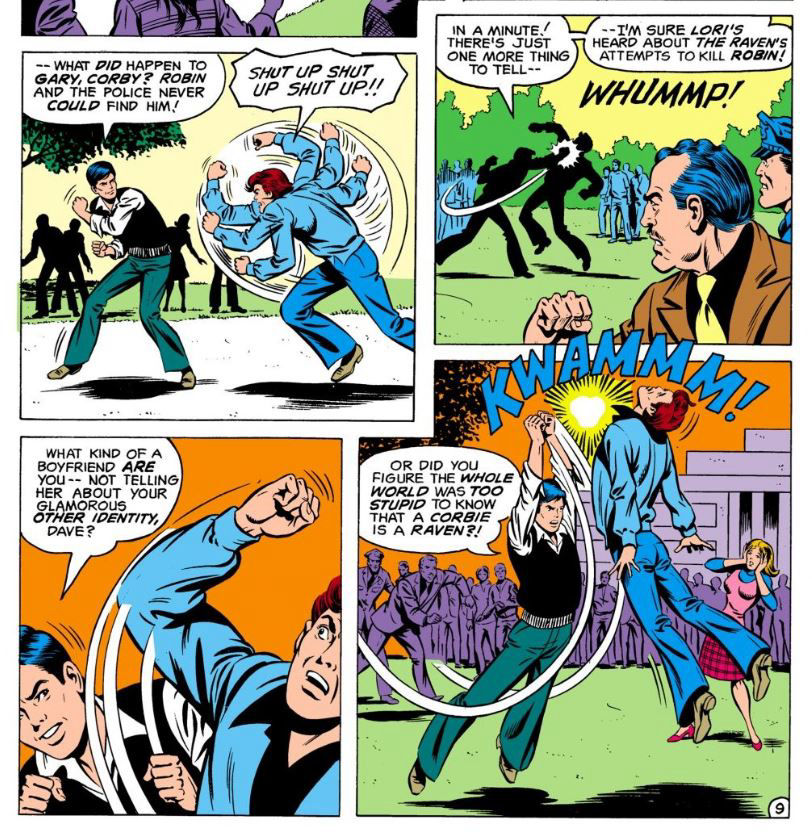
Raven turns out to be Dave Corby, Lori Elton’s new boyfriend. Dick fights Corby in their civilian identities as Lori looks on. Once the fight is over, Dick silently walks away from Lori. It’s her last appearance in the series, as it is also the last issue written by her creator Bob Rozakis.
Most of the remaining Robin stories in the Batman Family incarnation of Detective Comics were written by Jack C. Harris. Harris retained Chief McDonald (although sometimes spelled MacDonald) from the Rozakis issues, but otherwise moved on from what came before. There was a final team-up of the Dynamite Duo in Detective Comics #489, but it was unsatisfying for many long-term readers. Batgirl had her memories erased, and while they could be restored by listening to audio recordings of herself, Robin asked her not to listen to the tape about his and Batman’s identities. She complied and burned the tape – erasing her history with Dick Grayson. (Although a later writer revealed she just re-deduced Batman and Robin’s identities.)
Under the new status quo, Dick Grayson dates Jennifer Anne, a Hudson student who works with Dick on the campus newspaper. In Detective Comics #495 (October 1980) Dick Grayson learns that his activities have taken a toll on his academic studies.
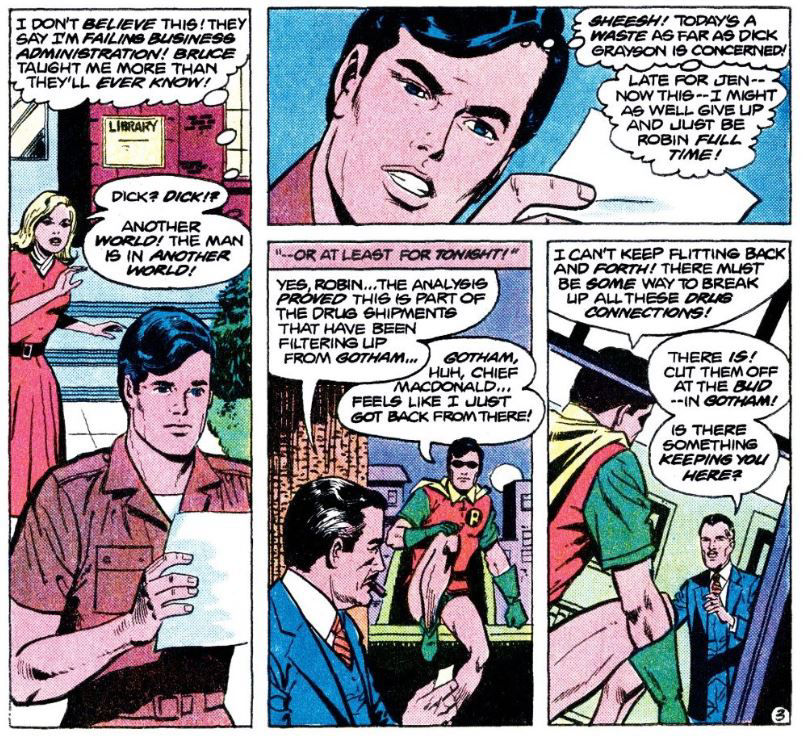
The problem is that Dick has cut too many classes. He’s given a chance to do a make-up research paper, but there are other concerns. The drug trade in New Carthage (Hudson University’s town) is all coming from Gotham. Dick repeatedly is confronted with the fact that the place to make a real difference is Gotham City. The final panel shows Robin on his motorcycle going back to Gotham.
As will be made clear in a subsequent issue of Batman, Dick Grayson has dropped out of Hudson University ending a decade’s long status quo.
Robin used to be part of a team called “the Dynamic Duo”, but many of these late 1970s set at Hudson University didn’t seem very dynamic. In the early 1970s, the stories had been infused with real world politics and there was sense that Robin’s view was expanding from what it had been. New Carthage might have been a smaller town than Gotham City, but it had felt as if Dick Grayson had entered a larger world. By the time of the Batman Family era, however, Hudson University seemed smaller, more familiar and safer.
The comics even called attention to the change in tone. In Detective Comics #291 when the Hudson Herald is attacked, one of the police demands “Now tell me what you newspaper kids ‘re puttin’ in that radical rag o’ yours.” Jennifer retorted “All that radical stuff dried out five years ago.”
It might seem as if Robin leaving Hudson University and returning to Gotham City is a step backwards, the end of a decade-long failed experiment. But in fact, the most radical changes to Robin were just around the corner.
NEXT:
PART 9 - Robin No More: The Birth of Nightwing (1980 - 1984)
PART 10 - Reboots and Retcons (1984 - Present)
PREVIOUSLY:
PART 1 - The Golden Age of Comics and the Development of the Kid Sidekick
PART 2 -What's In A Name? Robin and Robin Hood
PART 3 - Early Adventures (including Robin's origin)
PART 4 - Batman and Robin meet Robin Hood in The Rescue of Robin Hood (Detective Comics #116)
PART 5: The Caped Crusaders in 1950s and 1960s Comic Books and Television
PART 6 - Batman and Robin Meet the Archer (1966 TV episodes)
Contact Us